#Disadvantages of data warehouse
Explore tagged Tumblr posts
Text
What are Advantages and Disadvantages of Data Warehouse
What is data warehouse A data warehouse is a space where structured data is stored, analysed and fetched. The data can be historical data or new data. Small and medium-sized businesses don’t use data warehouses but use cloud-based services for storing data. Big organizations and multinational companies use data warehouses for storing their large data. Suppose a large company uses a data…

View On WordPress
#10 examples of data warehouse#Advantages of data warehouse#Benefits of data warehouse#Definition of data warehouse#Disadvantages of data warehouse#Drawbacks of data warehouse#Features of data warehouse#Merits and demerits of data warehouse#Pros and cons of data warehouse#What is data warehouse
0 notes
Text
Advantages and Disadvantages of Data Warehouse centralizes and consolidates large volumes of data from various sources, enabling efficient querying and analysis. Advantages include improved decision-making, historical data analysis, and enhanced performance. Disadvantages can involve high setup costs, complexity in data integration, and maintenance challenges, requiring skilled personnel to manage the system effectively. Check here to learn more.
0 notes
Text
Cut Costs, Boost Speed—AI in Small Biz Logistics Works!
In today's fast-paced global economy, efficiency and agility are no longer luxuries—they are imperatives. Small businesses, once at a disadvantage due to limited resources and manpower, are now breaking through barriers using AI in logistics to optimize operations, reduce costs, and stay ahead of customer demands. With artificial intelligence in logistics, even modest-sized companies can harness powerful tools that were once only within reach of enterprise giants.
AI has moved beyond theory and is now the engine behind a wave of innovation transforming everything from inventory management to last-mile delivery. For small businesses, this represents a genuine game-changer. By adopting AI for logistics, companies can intelligently automate tasks, forecast trends, and even reduce human error to nearly zero.
The accessibility of AI has dramatically increased due to cloud computing and affordable AI platforms that have democratized access to advanced tools. Additionally, the rise of data-driven decision-making means even small companies generate enough data to benefit from AI implementations. Competitive pressure in the marketplace is further driving small businesses to seek smarter solutions to stay relevant and profitable.
Several real-life success stories highlight how AI is transforming small business logistics across various sectors. Green Rabbit, a small U.S.-based e-commerce startup specializing in perishable goods, faced serious challenges in managing their cold chain. By partnering with AI consulting services, they implemented predictive analytics to monitor temperature-sensitive products in real time. This integration resulted in a 95% reduction in spoilage, increased on-time deliveries by 40%, and significantly improved customer satisfaction. Their experience showcases how small enterprises can integrate AI in logistics and supply chain operations to ensure freshness and compliance.
Lily AI started as a fashion retail tech startup but distinguished themselves with their AI-driven logistics strategy. They employed machine learning to analyze shopping trends, product returns, and inventory flow. As a result, their inventory costs dropped by 32%, stockouts reduced by 25%, and they experienced increased sales velocity. By embedding AI into their logistics solution, Lily AI ensured the right product reaches the right place at the right time, optimizing their entire supply chain.
In Hong Kong, FreightAmigo, a logistics aggregator startup, uses AI to automate freight forwarding, customs clearance, and route optimization. This technology implementation led to a 70% reduction in manual processing, decreased delivery delays by 30%, and created better real-time pricing transparency. Their story reflects how startups in Asia are leveraging AI in logistics to compete effectively with traditional global freight players despite their smaller size.
PreScouter, a research firm, applied AI tools to streamline their document and shipment routing when working with global clients. They developed a logistics app development solution integrated with AI to predict and manage delays across borders. This resulted in 50% faster delivery cycles and a 35% increase in overall operational efficiency. Their experience underlines how even service-centric companies can benefit from smart logistics implementations.
Boxed, an online wholesale retailer, used AI-powered robots to automate warehouse operations and manage fulfillment. Their hybrid approach blended robotics with AI forecasting models, which reduced warehouse costs by 60%, increased order accuracy to 99.5%, and provided real-time dashboard analytics for better decision-making. It stands as a prime example of logistics solutions that are future-ready and scalable even for smaller businesses.
The core benefits AI delivers to small businesses in logistics are numerous. Predictive analytics allows companies to anticipate demand, traffic delays, and supply chain disruptions. Real-time visibility provides a transparent view of shipments from origin to destination. Smart inventory management reduces overstocking or understocking using dynamic AI models. Route optimization minimizes fuel costs and time with intelligent recommendations. Finally, customer experience improves through better delivery times and increased responsiveness to customer needs.
For small businesses looking to integrate AI into their logistics operations, a complete infrastructure overhaul isn't necessary. The process can begin by identifying critical logistics pain points, focusing on areas where delays, human errors, or high costs occur, as AI works best when solving clearly defined problems. Next, leveraging modular AI tools that integrate into existing systems provides a practical starting point. Considering logistics app development with AI APIs that are scalable and budget-friendly can make the transition smoother.
Consulting with AI experts ensures businesses choose solutions tailored to their specific needs rather than oversized enterprise platforms. Implementation should occur in phases, rolling out AI in stages—beginning with route optimization, then scaling to warehouse management, and later to demand forecasting—allows for manageable adaptation and learning.
Looking toward the future, the integration of AI into logistics will not just remain a competitive advantage but will become a necessity. The rise of autonomous delivery, drone shipments, and AI-driven sustainability practices will shape the next decade of logistics operations. By embracing AI in logistics, small businesses are not just surviving—they are thriving. They are becoming faster, smarter, and more connected than ever before. Whether operating a boutique supply chain or a growing cross-border logistics network, there's a wealth of opportunity waiting to be harnessed.
The key is taking action now. AI is no longer "emerging tech"—it's here, it's affordable, and it's transforming the logistics landscape one smart decision at a time. AI has removed the guesswork from logistics operations. With actionable insights, automation, and predictive power, even the smallest players can scale like never before. The success stories mentioned aren't anomalies—they're blueprints for other small businesses to follow.
For those planning to future-proof their logistics operations, there has never been a better time to explore how AI in logistics and supply chain management can revolutionize business processes and outcomes. The transformation is not just possible but increasingly essential in today's competitive marketplace.
#hire developers#hire app developer#mobile app development#hire mobile app developers#ios app development#android app development#ai in logistics#logistics#supplychain
0 notes
Text
Choosing the Right Fire Suppression System: A Guide for Saudi Companies
In Saudi Arabia, where industries, commercial buildings, and infrastructure projects are subject to strict safety regulations, fire safety is a major concern for businesses. Selecting the appropriate fire suppression system is one of the most important fire safety measures. Before choosing one of the many varieties available, businesses must comprehend their unique requirements, risks, and legal requirements.
This guide will examine the various kinds of fire suppression systems, their advantages, and how businesses can select the best one to protect their resources and employees.
Understanding Fire Suppression Systems
The purpose of fire suppression systems is to contain or put out fires in confined spaces before they spread. In contrast to conventional sprinklers or fire extinguishers, suppression systems frequently operate automatically, guaranteeing prompt action in the event of a fire. For sectors with high fire risks, like manufacturing, data centers, oil and gas, hospitality, and healthcare, these systems are essential.
Essential Elements of a Fire Protection System
The following components make up the majority of fire suppression systems:
Detection System: Sensors that pick up heat, flames, or smoke.
Control Panel: The brain of the system, which interprets inputs and initiates suppression mechanisms.
Suppression Agent: The material (such as foam, gas, water, etc.) that puts out a fire.
The way the agent is released (pipes, nozzles, etc.) is known as the discharge mechanism.
Types of Fire Suppression Systems
The type of fire hazards present, the business's needs, and legal requirements all play a role in selecting the best fire suppression system. The following are a few of the most widely utilized systems in Saudi Arabia:
1. Fire suppression systems based on water

Among the most popular suppression solutions are water-based systems. These consist of:
Sprinkler systems: When smoke or fire is detected, water is automatically released.
Water Mist Systems: Utilize fine mist to minimize water damage by lowering oxygen levels and cooling flames.
Ideal for: Office buildings, retail centers, lodging facilities, warehouses, and residential structures.
Advantages:
reasonably priced and extensively accessible.
efficient against the majority of Class A fires (wood, paper, cloth, etc.).
satisfies many industries' regulatory requirements in Saudi Arabia.
Disadvantages
Unsuitable for locations with delicate electronic devices.
can result in assets being damaged by water.
2. Gas-Based Fire Suppression Systems

By eliminating oxygen or preventing chemical reactions, these systems put out fires using inert or chemical gases. Typical gases consist of:
FM-200: A residue-free, quick-acting cleaning solution.
Carbon Dioxide (CO₂): Good for suppressing small fires.
Novec 1230: A low-impact, environmentally friendly substitute.
Ideal for: Electrical control rooms, museums, telecommunications facilities, data centers, and IT server rooms.
Advantages:
It's perfect for electronics because it won't get wet.
quick-acting and requires little cleanup.
conforms to global fire safety regulations.
Disadvantages
more expensive initially than water-based systems.
Unsuitable for areas where people are present, particularly for CO₂-based systems.
3. Foam-Based Fire Suppression Systems

To put out fires and stop them from starting again, foam suppression systems combine water and a foam concentrate. Fires involving flammable liquids are the main application for these.
Ideal for: Airports, chemical plants, fuel storage facilities, and oil refineries.
Advantages:
Excellent for Class B fires (those involving flammable liquids, such as gas and oil).
stops re-ignition.
able to be combined with other systems.
Disadvantages
requires specific upkeep and installation.
Certain types of foam contain chemicals that might need to be taken into account when it comes to the environment.
4. Powder-Based Fire Suppression Systems

These systems stop fires' chemical reactions by using dry chemical powders.
Ideal for: Heavy machinery, mining operations, and industrial facilities.
Advantages:
works on a variety of fire types, such as electrical Class A, B, and C.
rapid suppression with little use of agents.
Ideal for harsh and outdoor settings.
Disadvantages
requires appropriate cleanup following release.
can make it difficult to see in confined spaces.
5. Hybrid Fire Suppression Systems
Hybrid systems improve fire safety by combining gas and mist suppression. Because of their effectiveness, these are becoming more and more popular in Saudi Arabia.
Ideal for: Mixed-use buildings and specialized industrial applications.
Advantages:
reduces environmental impact while offering high suppression efficiency.
less upkeep than conventional systems.
Ideal for settings that need both chemical suppression and cooling.
Disadvantages
can be costly to install.
For optimal effectiveness, a combination of detection systems might be needed.
How to Choose the Right Fire Suppression System for Your Business
Choosing the right fire suppression system requires consideration of multiple factors:
1. Evaluate Your Risks of Fire
To find possible risks in your facility, do a thorough fire risk assessment. Think about:
the kinds of materials used or kept.
the existence of electrical apparatus.
if there are people in the area.
2. Adhere to the Fire Safety Regulations in Saudi Arabia
Different industries have different fire safety requirements set by the Saudi Civil Defense and other regulatory bodies. Make sure the suppression system you select satisfies these specifications.
3. Examine Price vs. Level of Protection
Prioritizing fire safety can help businesses avoid major financial and operational losses in the event of a fire, even though cost is a crucial consideration.
4. Assess the Need for Maintenance
While some suppression systems require less maintenance, others need regular inspections and agent refills. Select a system based on your ability to maintain it.
5. Speak with a Fire Safety Professional
Appropriate system selection, installation, and maintenance are guaranteed when you work with a seasoned Saudi fire and safety firm like Axontec International. A certified provider can assist in creating a customized solution that satisfies operational and legal requirements.
Conclusion
Any Saudi Arabian company that wants to protect people, property, and business continuity must invest in fire suppression systems. Understanding your unique fire risks and selecting a solution that complies with industry regulations and operational requirements are crucial, regardless of whether you decide to use a water, gas, foam, powder, or hybrid system.
Your company will remain secure and compliant with superior fire suppression solutions if you partner with a Salama-approved fire and safety company like Axontec International. By making the proper system investment now, expensive catastrophes can be avoided later.
#saudi arabia#homesafety#businesssecurity#fire and safety#cctv installation#fire protection#fire extinguisher#fire alarm system installation
0 notes
Text
Enterprise Data Warehouse (EDW) Market Report 2025-2033: Trends, Opportunities, and Forecast
Enterprise Data Warehouse (EDW) Market Size
The global enterprise data warehouse (EDW) market size was valued at USD 3.43 billion in 2024 and is estimated to reach USD 22.36 billion by 2033, growing at a CAGR of 19.29% during the forecast period (2025–2033).
Enterprise Data Warehouse (EDW) Market Overview:
The Enterprise Data Warehouse (EDW) Market The report provides projections and trend analysis for the years 2024–2033 and offers comprehensive insights into a market that spans several industries. By fusing a wealth of quantitative data with professional judgment, the study explores important topics such product innovation, adoption rates, price strategies, and regional market penetration. Macroeconomic variables like GDP growth and socioeconomic indices are also taken into account in order to put market swings in perspective. An Enterprise Data Warehouse is a centralized repository designed to store, manage, and analyze vast amounts of structured and unstructured data from various sources across an organization. It serves as a critical component for business intelligence (BI), enabling organizations to consolidate data from different departments or systems into a single, cohesive view. This allows for comprehensive data analysis, reporting, and decision-making. The main market participants, the industries that employ the products or services, and shifting consumer tastes are all crucial subjects of conversation. The competitive environments, regulatory effects, and technical advancements that affect the market are all carefully examined in this study. The well-structured Enterprise Data Warehouse (EDW) Market Report provides stakeholders from a variety of political, cultural, and sectors with useful commercial information.
Get Sample Research Report: https://marketstrides.com/request-sample/enterprise-data-warehouse-edw-market
Enterprise Data Warehouse (EDW) Market Growth And Trends
Numerous Enterprise Data Warehouse (EDW) Market breakthroughs are driving a significant shift in the industry, altering its course for the future. Following these important changes is essential because they have the potential to reshape operations and plans. Digital Transformation: Data-driven solutions enhance customer contact and streamline processes as digital technologies develop. Customer Preferences: Businesses are offering customized items as a result of the growing emphasis on convenience and personalization. Regulatory Changes: Companies must quickly adjust in order to stay competitive as compliance standards and rules become more stringent.
Who Are the Key Players in Enterprise Data Warehouse (EDW) Market , and How Do They Influence the Market?
Amazon Web Services (AWS)
Microsoft Azure
Google Cloud
Snowflake
Oracle
IBM
SAP
Teradata
Cloudera
Hewlett Packard Enterprise (HPE)
Alibaba Cloud
Dell Technologies
Hitachi Vantara
Informatica
Huawei
With an emphasis on the top three to five companies, this section offers a SWOT analysis of the major players in the Enterprise Data Warehouse (EDW) Market market. It highlights their advantages, disadvantages, possibilities, and dangers while examining their main strategies, present priorities, competitive obstacles, and prospective market expansion areas. Additionally, the client's preferences can be accommodated by customizing the company list. We evaluate the top five companies and examine recent events including partnerships, mergers, acquisitions, and product launches in the section on the competitive climate. Using the Ace matrix criteria, their Enterprise Data Warehouse (EDW) Market market share, growth potential, contributions to total market growth, and geographic presence and market relevance are also analyzed.
Browse Details of Enterprise Data Warehouse (EDW) Market with TOC: https://marketstrides.com/report/enterprise-data-warehouse-edw-market
Enterprise Data Warehouse (EDW) Market : Segmentation
By Deployment
Web Based
Server
Hybrid
By Product Type
Information Processing
Data Mining
Analytical Processing
Others
By Data Type
Billings
Documents
Records
Financials
Others
What Makes Our Research Methodology Reliable and Effective?
Data Accuracy & Authenticity – We use verified sources and advanced data validation techniques to ensure accurate and trustworthy insights.
Combination of Primary & Secondary Research – We gather first-hand data through surveys, interviews, and observations while also leveraging existing market reports for a holistic approach.
Industry-Specific Expertise – Our team consists of professionals with deep domain knowledge, ensuring relevant and actionable research outcomes.
Advanced Analytical Tools – We utilize AI-driven analytics, statistical models, and business intelligence tools to derive meaningful insights.
Comprehensive Market Coverage – We study key market players, consumer behavior, trends, and competitive landscapes to provide a 360-degree analysis.
Custom-Tailored Approach – Our research is customized to meet client-specific needs, ensuring relevant and practical recommendations.
Continuous Monitoring & Updates – We track market changes regularly to keep research findings up to date and aligned with the latest trends.
Transparent & Ethical Practices – We adhere to ethical research standards, ensuring unbiased data collection and reporting.
Which Regions Have the Highest Demand for Enterprise Data Warehouse (EDW) Market?
The Enterprise Data Warehouse (EDW) Market Research Report provides a detailed examination of the Enterprise Data Warehouse (EDW) Market across various regions, highlighting the characteristics and opportunities unique to each geographic area.
North America
Europe
Asia-Pacific
Latin America
The Middle East and Africa
Buy Now:https://marketstrides.com/buyNow/enterprise-data-warehouse-edw-market
Frequently Asked Questions (FAQs)
What is the expected growth rate of the Enterprise Data Warehouse (EDW) Market during the forecast period?
What factors are driving the growth of the Enterprise Data Warehouse (EDW) Market?
What are some challenges faced by the Enterprise Data Warehouse (EDW) Market ?
How is the global Enterprise Data Warehouse (EDW) Market segmented?
What regions have the largest market share in the global Enterprise Data Warehouse (EDW) Market?
About Us:
Market Strides is an international publisher and compiler of market, equity, economic, and database directories. Almost every industrial sector, as well as every industry category and subclass, is included in our vast collection. Potential futures, growth factors, market sizing, and competition analysis are all included in our market research reports. The company helps customers with due diligence, product expansion, plant setup, acquisition intelligence, and other goals by using data analytics and research.
Contact Us: [email protected]
#Enterprise Data Warehouse (EDW) Market Size#Enterprise Data Warehouse (EDW) Market Share#Enterprise Data Warehouse (EDW) Market Growth#Enterprise Data Warehouse (EDW) Market Trends#Enterprise Data Warehouse (EDW) Market Players
0 notes
Text
The Backbone of Global Trade: Navigating the Transport and Logistics Industry

Have you ever thought about the complexities of vehicles, warehouses, and logistics teams that bring your favourite products right to your doorsteps? The journey of goods from manufacturer to consumer is indeed a complex process that is described by the terms transport and logistics. If you are willing to gain an understanding of these complexities, a Transport and Logistics Course will equip you with the knowledge and skills needed to understand such a system. Understanding the dynamics of transport and logistics is important for any business to be able to thrive in the competitive marketplaces of today’s global economy.
The Interconnection of Transportation and Logistics
Transportation and logistics are the two sides of one coin. While transportation is more concerned with the physical movement of goods from one location to another, logistics concerns the broad range of planning, implementing, and controlling the flow of goods, ranging from warehousing and inventory management to order fulfilment and distribution. Both together ensure that products are delivered efficiently to meet customer demands and maintain operational excellence.
Advantages of Efficient Transportation and Logistics Management
Improved customer loyalty: Transport and logistics management is quite helpful in customer satisfaction. When products come on time and in good order, customers like returning to their vendors for more. Faultless logistics helps them have confidence and dependence on their service, which is a critical element needed to encourage loyal customers.
Reducing Operational Cost: Streamlining logistics operations guarantees significant cost savings. This can be further built through a focused review of transportation routeings for better inventory level and warehouse management. Such an understanding can facilitate the identification and application of processes that reduce waste.
Driving Growth through Efficiency: An efficient transport and logistics system can drive overall business growth. By ensuring that products are delivered swiftly and accurately, organisations can expand their market reach and increase sales. Learning how to implement best practices in logistics management will help you contribute to your organization’s growth strategy and make you a valuable asset in any business environment.
Adapt to the Shift in Demand: The logistics and transport industry is changing over time due to market trends, consumer preferences, and developments in technology. Professionals in this field are supposed to adapt accordingly. By taking the course in logistics and transport management, you will develop an understanding that will enhance your knowledge of shifting demands while implementing flexible operations.
Challenges Faced by the Transportation and Logistics Sector
Increasing Regulatory Compliance: The transportation and logistics industry is governed by countless regulations that encompass everything from safety standards to environmental guidelines. Therefore, a proper understanding of these regulations is the key to making your way through this complex landscape.
Increasing Fuel Costs: High fuel prices may be one of the most critical cost drivers in transportation, influencing price setting to profit margins. In this regard, organisations have to seek ways of minimizing these costs through route optimization, fuel-efficient vehicles, or alternative sources of energy.
Supply Chain Disruptions: These are disruptions due to natural calamities, geopolitical events, and other unforeseen events that may cause delays and increase costs. Therefore, developing risk management plans in order to minimize the impact of such events is crucial.
Technological Changes: With technology also come several disadvantages in the transport and logistics industry. New software, automation tools, and data analytics might be a lot to handle and keep up with. Understanding how to use technology for operational efficiency is one of the major focuses of logistics and transport management courses, which will help you stay ahead in this fast-changing environment.
Explore UniAthena’s Logistics and Transport Management Course
This Transport and Logistics Course covers the dynamics of transportation and logistics from a global view. In as little as 1–2 weeks of self-paced free learning format, this course will provide you with an understanding of topics such as the world transportation system, INCO terminology, and the principles that underpin logistics.
You will also gain insight into how goods are moved across international borders and thus will be able to lead, plan, and manage transportation and logistics networks in any industry. Additionally, you will get a chance to earn a Blockchain-verified certification upon success, an added bonus to your professional profile. Take advantage of this opportunity and enhance your skills and knowledge with this Logistics and Transportation Management Course. Sign up now.
0 notes
Text
I don't have a doodle today but I did want to talk more about the plot I had going on here! It's beefy so just get comfy and enjoy the ride.
So, a quick rehash is that Silver goes back to the past to prevent the future he is from. GUN is used to this anomaly by now and often send personal to go pick up Silver if they pick up the chaos energy. Silver ends up attacking them though because of his distrust of humans.
In Silver's future, chaos energy caused a nuclear fallout of sorts, and there's a unending winter on the planet. During the "canon event", Eggman opened up his warehouses to humans only. This is because humans in this AU are sensitive to chaos energy and Eggman felt like they had priority. From this... The Eggman Empire actually happens. Then there's a big divide between humans and animals due to loyalty to the empire.
I was going to have Eggman Nega be the overlord in Silver's timeline... But with a twist! This Eggman Nega would be a Maria-esque like person and genuinely think she's doing a good thing. She thinks the separation is necessary as the chaos energy is so rampant on the surface. Anything that is on the surface is mutated by this radiation and is what grants psychic abilities. So, this makes humans at a 'disadvantage' and need protection from mutated mobians.
Not the strongest of reasons to make an overdramatic future... but not bad! The only thing I would probably rewrite was the lack of food both factions had. As it was implied that cannibalism was an option if there was no food sources available. This was supposed to be like a contention between why the two factions would fight but... Just seems pretty weak to me nowadays.
Anyways, Silver doesn't trust humans due to the Eggman Empire and humans actively going against their word where he's from. If I recall correctly, Sonic is sent by GUN to disarm and calm Silver. Which works! Silver is detained by GUN and there's a meeting about what to do with him... And Shadow offers to take him home.
Shadow in this AU is a GUN agent. Which has been disproven in recent games! But like, I just felt like Gun wouldn't ever really just let shadow walk free... And I feel Shadow would hate being confined again! So, a compromise is for Shadow to work for GUN (including being monitored by them) and GUN will continue to create a cure from Shadow's DNA. (Per Shadow's request to honor Maria's memory) A reminder Shadow made this agreement at age 15, so yes, he is a bit screwed in terms of what data they've taken from him...
Anyway, the monitors in his house I thought made a perfect excuse to make this an ask blog! Where the questions were from GUN agents (which was why you could read their profiles) and you got to see what was going on in Shadow's apartment! I had a floorplan for it too.
Aaaand I left the plot there for a moment while I answered asks and worked more on the story. The magic anons where always my favorite ones to answer and I liked having the friendship between Shadow and Silver be more on focus. :)
The media I really really wish I had were the comics I would release that related to the main plot. Particularly the Arc Chronicles 🥺 those were sooooo good. I bring those up because it's from those comics that the canon event is hinted at!!
I'm pretty sure I choose the Yellow Chaos emerald to get cracked and release a steady flow of chaos energy. For this AU, the chaos emeralds and the master emerald keep the chaos energy in balance on the planet... since one was cracked and loosing energy.... ya know... that means the other emeralds are going to go out of balance.
To fix that, Silver wants to get the Light Gaia bracelet to attempt to restore the emerald. Though, they don't know where that item is (Sonic has it) and as Silver works towards a solution, his feelings for Shadow grow to a point where he doesn't want Shadow to get involved with this. This is because when racing against Amy, Silver is told about a prediction she has, where the canon event is and how Shadow is involved.
I DID find a reblog of this that I'll post here for context




But only Amy and Silver know! That other person? Isn't Shadow. If I recall, Turmeric was his name and he was a shadow android. (More like they were cyborgs but shoosh) Turmeric had yellow stripes and was based on the yellow shadow in the Shadow the Hedgehog game multiplayer mode.
There were a few shadow androids like Turmeric who were sentient! I thought it would be cool to bring back Mephiles the Dark, but as an unsettling clone. Since Mephiles and Turmeric where only sentient due to a few mutations. I wanted Shadow's doubt about being the real Shadow more believable... And having sentient androids a good step in that direction.
Mephiles and Turmeric work for Eggman still, with Turmeric being a bit more of a wild card. (He was my own Shadow OC so I could do whatever) Mephiles had let himself get caught by GUN and stays in the prison cells there. There were a few asks were Shadow is interrogating him and it hints Mephiles has a lot of secret knowledge. (He might actually be Mephiles!)
Regardless, these two were important as they feed Eggman information on GUN and other stuff. Such as the prediction Amy had. Eggman wanted the information particularly because he wants to find a way to quietly replace the real Shadow with a fake. Since Eggman felt like his grandfather's creation shouldn't go back to the hands that took everything from them. Eggman was also having conversations with Shadow in a warehouse that GUN couldn't access. I was planning to have video feed be established so that you could ask Shadow questions there. (I had so many irons in the fire this entire time)
And yes, this was going to cause an misunderstanding between Shadow and Silver since Shadow is in cahoots with Eggman. This causes Silver to break off whatever situationship they're in and go to Sonic's house. Silver confides in Sonic who listens but ultimately Sonic says something wise but on accident like "huh, I couldn't imagine my life being in the hands of others, I love adventuring too much." And Silver is like, damn, ok, gotta rethink the situation Shadow is in.
During Sonic's party (I think it was a birthday), Shadow shows up and Silver takes time to talk with him. Nothing is more intimate then a rooftop talk at night while a party is softly playing in the distance. :3
Anyway, they make up and then go back to the party and Sonic, being the nosy friend, asks if they made up. They have, and Silver has an announcement. (This was before snapcube) Silver tells everyone what is going on in the future and mentions looking fruitlessly for the Light Gaia Bracelet... The one Sonic has in his house!
Silver decides if he makes it a plan with GUN, that Shadow would be allowed to travel with him to the temple in Spagonia and let Shadow see the world. Amy speaks up about her vision again (as Amy is psychic in this AU and technically Silver's ancestor) and warns about Shadow accompanying. Of course, these two are still on the high of feeling good so they disregard it because they're aware of the prophecy.
I didn't want to plan too far ahead, so I was going to leave another opening for asks for their 'vacation' in Spagonia.
Then I stopped and deleted the blog. I never expected to do that and to do that so suddenly. Please, don't ask why, and know that this blog can't be restored. However, I couldn't bare the thought of someone taking the blog's handle or feeding my work to AI. Part of me still cares about this story and that's what I hope has brought you back to this blog too.
I don't know what this blog's future is, but it's here.
1 note
·
View note
Text
Selling on Amazon FBA/FBM in 2025 from the seller's perspective: is it still worthwhile?

Is Selling on Amazon Still Worth It?
We want to share our experience as a multi-channel seller on Amazon, eBay, and our own online store for the past five years. 👉 Key Topics Covered: ✔ Is Selling on Amazon in 2025 Still Profitable? We analyze fees, competition, and the changing e-commerce landscape. ✔ How to Set the Right Product Pricing: Learn about unit economics and profit margin calculations with a handy price calculator template. ✔ Navigating Amazon’s Bureaucratic Pitfalls: From GTIN (Amazon barcode) requirements to account suspension risks, avoid common headaches. ✔ Winning the BuyBox: Strategies to compete against Amazon itself and other sellers. ✔ Dealing with Returns: Tips for minimizing losses from Amazon’s lenient return policies. ✔ Cash Flow Management for Sellers: How Amazon’s payment cycles and reserves impact your business. ✔ Message Overload: Managing the flood of Amazon notifications and maintaining account health. ✔ Alternatives to Amazon: Discover platforms like eBay and Shopify, and creating your own online store.
Pricing Strategies in a Competitive Marketplace. Price Сalculator.
Let's assume you already have a product to sell. The fundamental question is one of price. Determining the correct price for a product on Amazon is a delicate balance. You must consider the platform's fees, the cost of returns, and the competition within the BuyBox.
In order not to trade at a loss, you need a calculation. We have prepared a simple table template. You can get this ready-to-use spreadsheet using links below or compose something similar yourself.

In the gray fields, enter the initial data: purchase VAT (if the product is imported, it may differ from the retail price), sales VAT (if required for the country of sale), approximate percentage of shipping and storage costs (from the purchase price), Amazon Referral fees, Amazon FBA fees for one average unit (must include delivery to warehouse and logistics from warehouse to buyer), percentage of returns unsuitable for further sale, costs of processing and packaging the product, and the desired Profit Margin.
A couple of comments. Usually, the issue of customer returns is delicately omitted by various online coaches, but it will give you a lot of headaches. While customer-friendly, the overly lenient Amazon return policy often leaves sellers at a disadvantage, with a high return percentage eating into profits
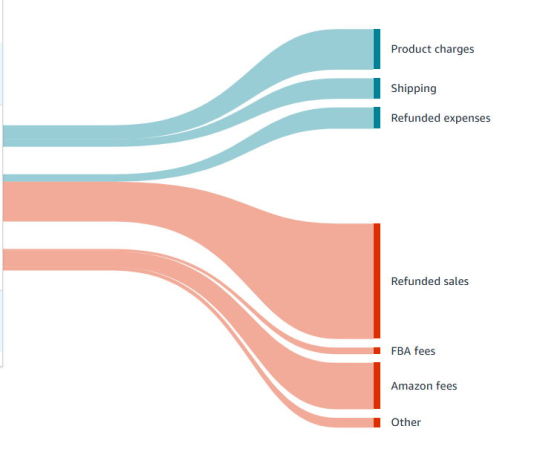
Statistics show gigantic (and growing) volumes of returns, the percentage of which fluctuates from 5 to 40, depending on the category. Most returned goods are unsuitable for further resale - just look at this sample returned from Amazon.

One of the ways to automatically check buyers for reliability and propensity for returns and fraud is TreeTalk Credenza. This useful tool helps to store order data in a GDPR/CCPA-compliant manner and checks buyer ratings in a semi-automated mode using both local and crowdsourced databases.

If you already use this software, the refund rate may be reduced, but we still have to consider it, because a return is not just a loss of revenue on the product, it is also a loss in storage and delivery back and forth from the buyer, and with the FBA scheme - also to the Amazon warehouse and back to you. Therefore, we must take this into account.
As for the Profit Margin, it may seem big to some, but later you will understand why you should not set it too modestly.
In the table itself, we enter the purchase price and, if necessary, the exchange rate if the purchase currency differs from the sale currency.
White fields will be calculated automatically based on the entered data. The "No-profit FBM price" column calculates the minimum price for selling without profit using the FBM scheme (Fulfillment by Merchant, i.e. with your logistics), the "FBM price" column calculates the acceptable price for selling using the FBM scheme, and the "FBA price" column calculates the acceptable price for selling using the FBA scheme (Fulfillment by Amazon, that is from a warehouse and with Amazon logistics).
Here are the first results. We see that a product purchased at a price of $50 or more should be sold at three times the price, and a cheap product at least four times the price.

The calculation formulas for expensive and cheap products have different empirical coefficients. When calculating for your product, just copy the corresponding line.
Now we have a minimum price. However, reality may make adjustments. Study BuyBox and competitors' offers. If their prices are higher - great, enter your final price in the last two columns and mark it green. However, the price of competitors or Amazon itself for the same or similar product may be lower than the calculated one. If the product has already been purchased, you will be forced to lower the price. It's good if it still allows you to make money...
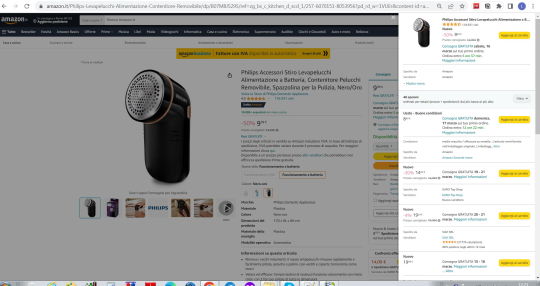
Amazon's own competition in the BuyBox can be particularly disheartening, as the platform often prioritizes its products or those of larger sellers, making it difficult for smaller businesses to get a fair share of visibility.
Dividing the pie. Who gets the lion's profit share?
To check the business model, we have two Reverse check tabs. We transfer the values from the first table or adjusted figures to the "Initial data" section. In the gray Price field, we indicate the real selling price. And we get Unit Economics for your product in real money.
So, when selling a product on Amazon, bought for 100 euros, for 310 euros, you will receive about 38 euros of them (roughly 12%). Is there an error here? No, everything is correct - the control figure of 37.8% shows a marginality close to the specified one. What's the trick? It should be taken into account that you indicated the desired marginality from the purchase price (100 euros), and Amazon and the state take their commissions from the selling price (310 euros). As a result, Amazon is the main beneficiary of your activity, having 70 euros or more than 22 percent of the pie. The state is not far behind, having 22 percent in the form of VAT (you will pay other taxes from your share later).
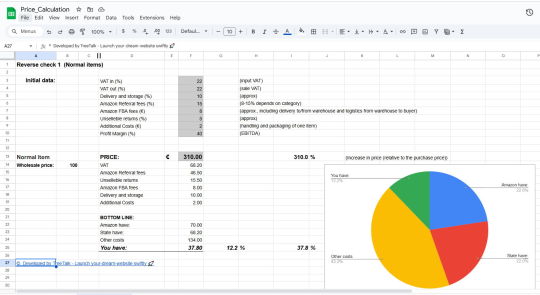
There's nothing we can do about government bureaucracy at the moment. Still, a reasonable question is: what if, instead of giving Amazon the lion's share of the revenue, we sell the goods in our own online store, for example?
Just memorize this idea. We will return to this later, but for now - the second tab Reverse check.
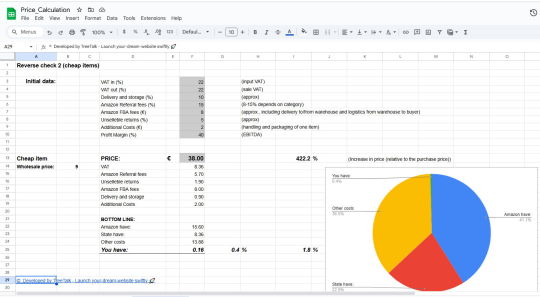
It contains the calculation of Unit Economics for a cheaper product.
Let's see, to make a profit we sell the product almost 5 times more expensive than the purchase price, for 44 euros. Of this, you will receive less than 4 euros (about 8 percent). Conversely, Amazon has more on the cheap product - 38 percent.
But what if competition forces you to lower the price? Let's see. Trouble! At a price of 40 euros per unit, your share of the pie will decrease dramatically, to 3 percent. And at a price of 38 euros, your revenue will fall to zero. At the same time, the state will still get its swag, and Amazon's share will even increase, wow!
Like our spreadsheet? You can buy it right now by paying securely with Stripe here. Or you can get it for free by subscribing to our partners' news - TreeTalk Credenza.
But let's continue. Okay, let's put the price back in place, so the math is not so scary. But if you think that since you are in profit, you can live happily on your couple of bucks, I have to disappoint you...
Navigating Amazon's "Innovations" and Pitfalls: Wierd Cash Flow
In the "Payments" section on Amazon, you will find beautiful graphs. Let's take a look and figure it out. This is a chart from a real test account.

First of all, pay attention to the payment date. Amazon pays money to your account twice a month. So, you will not receive the money immediately, as if it were your own store. Plan your churn rate taking this into account! And you, as we have already figured out, will only receive part of the money. Amazon will keep a little less than half. But remember - you must pay VAT from the Net volume from sales (that is, from your share and from Amazon's share). By the way, what are these "Promo rebates"? Yes, get used to it: Amazon will pay for promotions and benefits for premium customers out of your pocket.
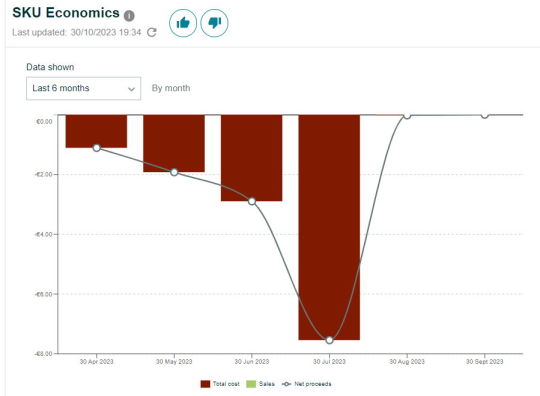
Let's look at another interesting graph from the Amazon admin panel. It shows what happens if you send a product to an Amazon warehouse but it doesn't sell. The cost of storage and maintenance increases every month. So don't forget to recall such products from the warehouse.
Well, let's imagine that you have succeeded and your sales are growing. Let's look at another chart.

We optimized prices and refused Amazon's warehouse and logistics services, and it seems like Amazon's share has decreased. But why, with sales of 1084 and a balance of 1315, will we only get 565 in the next payment (in 2 weeks again)? Note the interesting figure - 749 in the Account Level Reserve. This is the money that Amazon will keep as insurance against returns. The more sales, the greater the reserve. It can only be received by you with zero sales. That is never?
Navigating Amazon's "Innovations" and Pitfalls ... and lots of small bumps
Global Trade Item Number (GTIN) and barcodes for Amazon
To sell a product on Amazon, it must have a GTIN - Global Trade Item Number (EAN or UPS barcode). You can find what is it in the wiki, but for now, it is important to remember three things.
If the manufacturer of the product has already assigned it a GTIN, this is good, but it means that many sellers can sell it.
If the product does not have a GTIN (like many Chinese items), you will have to register and get your own numbers. In most countries, this is a paid service and involves a subscription. GTINs are also resold, but buying a dozen (or a hundred) of other people's numbers is a bad idea; Amazon will sooner or later discover that they do not correspond to the product, and the item will be blocked.
Before creating a product card, always verify the GTIN using the official service to avoid delays or blocking.
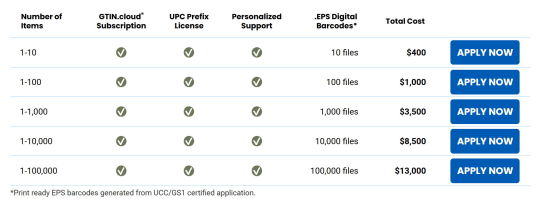
Tricks with BuyBox Amazon: How do you win?
It's great if the product sells well. But be careful: in this case, Amazon can invite the manufacturer, or start selling it itself. In this case, your competitive chances are small. Look, our price is lower, and the leader of the BuyBox is still who do you think?

European regulations: additional bureaucracy issues
Want to sell your product on Amazon to European countries? Make sure your account meets:
DAC7 : European tax number and other details required;
European address and representative required for returns and customer service;
Electrical product certification required (in some countries);
Contract and registration numbers required for packaging disposal;
New requirements are coming in regularly.
Missed something? Get an unpleasant notification:

Didn't miss anything and took everything into account? This is also not a guarantee against problems. Let's move on to the frightening part.
The risk of suspension / blocking listings and the Amazon account as a whole. Account health.
Take a look. We received such a notification last year. And when? On the eve of Black Friday! We discovered that our account and all listings were blocked, and Amazon offered to take the goods from warehouses or they destroy them!
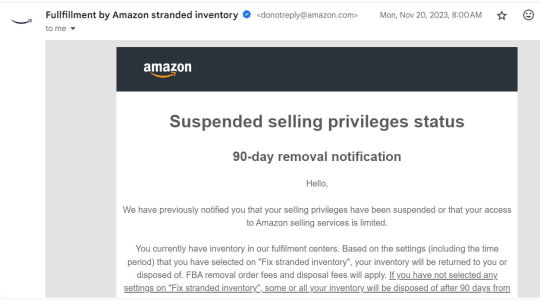
What was that? Look at the response from Amazon support:

"a periodic account verification is a standard procedure, which can take 10 days or more"
In the end, our account and listings were unblocked, but we missed a week of shopping and sales. And we were lucky, I think! Just google the chilling cases of Amazon account blocking with millions of dollars stuck in limbo!
In general, an account can be suspended or blocked for many reasons and "policy violations" that you may not even be aware of. So visit the Account Health section of your Amazon dashboard often.

Messages from Amazon: how to deal with dozens of them?
After the scary chapter about account blocking, let's relax a bit and see what messages come from Amazon, say, during the week.
Take action: One or more of your offers are not eligible to be a Featured Offer (Buy Box)
The most frequent message, speaks for itself.
Your payment is on the way: Disbursement Attempted
Great news! But why "attempted"? What can go wrong? A lot! Firstly, Amazon sends money not to all accounts, but only to accounts in trusted banks, the list of which is constantly changing. Secondly, before each money transfer by account details (IBAN), Amazon checks whether it can rip off money from your linked Amazon credit card, which must also be verified. Periodically, on one or another national Amazon, the account or card may be "unlinked", respectively, disbursement does not pass, and you need to verify another card.
Commande à expédier et chargement de facture
This is a good message - there is a new order to be sent. Why in French? Each national Amazon sends mail in its own language...
Action required: Provide GPSR compliance information
This is a 2024 innovation, a "surprise" from the European Commission. Now it is necessary to:
• Appoint an EU-established Responsible Person; • Display the contact information for the manufacturer on your listings and labels (in other words, disclose it to competitors and Amazon itself); • Provide "Warning and safety information".
Usually, when we receive a message like "Action required" from Amazon, we prefer, instead of spending time on fulfilling Amazon's requirements, to invest this time in improving our own website and promoting products on it - and it pays off!
But, in this case, there is a real threat of deactivation of listings and impact on "Account Health", so this message should be taken seriously and time should be spent on studying and fulfilling the new requirements.
On average, Amazon sends 40-50 emails a week, some of which require urgent attention. So the next very popular question seems to already have an answer:
Is Amazon FBA passive income?
Of course not! If you receive fifty emails a week that require a response, then this is more like full-time employment! And if you remember that Amazon itself receives the maximum revenue from your sales on Amazon, then in fact this is true - by selling goods on Amazon, you work for Amazon.
If you don't like this kind of thing, we can help. We know that dealing with Amazon's requirements takes time and effort. That's why we offer Amazon account administration, Amazon account management, running an Amazon store and creating product listings (use discount code YourStore202403).
But what's far worse is that your business is completely dependent on the marketplace, which can change the rules at will at any time.
Is there an alternative to Amazon for selling physical goods?
Yes, several alternatives offer you varying degrees of freedom and control. Here are some options, listed in order of increasing freedom: 1. Other Marketplaces, like eBay, Etsy or Walmart Marketplace are user-friendly, but you still have limited control over the branding, pricing and customer experience. 2. Platforms Offering Modular Constructions, like Shopify or BigCommerce allow you to create a customized online store, giving you more control over the design and functionality of your store. However, they still come with monthly fees, transaction costs and limited customization options. 3. Your Own Online Store on Own Hosting gives you maximum freedom.
Building your own online store on a self-hosted platform like WordPress with WooCommerce or Magento, you have complete control over the design, functionality, cash flow and customer experience. Yes, it requires more initial efforts, which, however, pays off quickly.
Don't know where to start? Contact the experts. TreeTalk will help you create and launch your independent online store or modern landing for your product in 1-2 weeks. And with a discount code (YourStore202403), it will be even cheaper.
There's no need to limit yourself to just one sales channel. If you think you've got the strength to handle several sales channels at once, you can do it. Using the right tools can make your task a lot easier. For instance, TreeTalk Credenza software will gather your imported orders from marketplaces and your own store into one local database, in line with GDPR, and will also automatically check the buyer rating. The check is done not only on your company's internal database, but also on the depersonalized crowdsourced database. This way, you can probably cut down on the risks from unscrupulous buyers and reduce the percentage of returns.
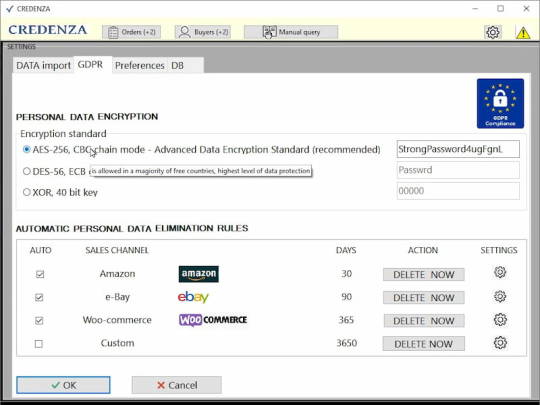
Conclusion. Selling n Amazon for profit? It's possible, but not easy.
This article is just a brief overview, so we didn't get into all the nitty-gritty details. We still didn't cover many important things, such as the ins and outs of the A-Z warranty claims, how to handle returns and losses in the Amazon Fulfilment Centers, what to do with damaged goods, or how to negotiate contracts for packaging disposal in different countries.
Subscribe to our YouTube channel-1 and channel-2 now to stay up to date with our latest video reviews and ask your questions in the comments. We will do our best to answer everything.
If you find this article interesting and informative, share it with your colleagues. Thank you for reading and we wish you success in your commerce!
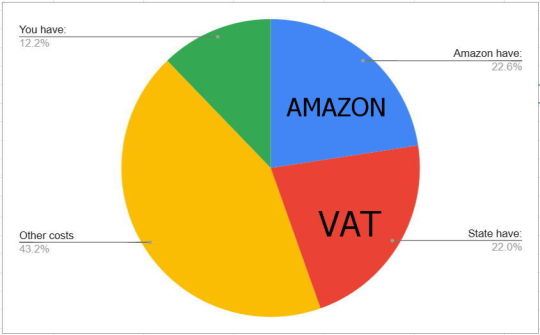
Optimal product pricing on Amazon
1 note
·
View note
Text
(Sorry about the crap in the lead-in above. This is how the text arrives when I insert the story. Tumblr's process won't let me fix it.)
I tried to use the map. Input is easy, but I think one has to have a warehouse full of computers (i.e., a computer farm) to get the story you're trying to understand. Plus, a PhD would be helpful.
First I enter the geographic area. I asked for Chicago, and the map gives me the "Chicago Urban Area." The year 2023 is selected. A 100 year average is selected (versus 20 years). I see an "All Sector" result, and I think I see that all sectors spew about 134 million tons of CO2 equivalent for the year 2023 from 595 sources. (I think transportation is considered a "source".) Now we select the sector. I asked for residential onsite fuel usage. The spew is 12.15 million tons. Does that mean anything to me? Nah, but I see how it can be important to urban planners.
You can fiddle with the map if you click/tap on the caption of this story, as messed up as it is, and do your own inputs.
Excerpt from this story from Climate Trace:
Every day, humanity pumps greenhouse gases into the Earth's atmosphere. Measuring those emissions starts with knowing where they’re coming from and what is causing them. So Climate TRACE identifies the locations of large sources and observes them over time.…not just the obvious things, like fossil-fueled power plants and factories, but also the tricky ones that move, such as ships and planes.…as well as the less-obvious ones, like landfills and fields for rice cultivation.
We combine many sources of information, because the more we know about each emissions source, the better our dataset becomes. Satellite imagery is one important way that we document emissions-causing activities. We might see a smoke or water vapor plume from above. Or a heat signature of a furnace from infrared imagery. We assemble these observations on an ongoing basis, to understand how facilities change over time.
Then we gather what’s known as “ground truth” data (snippets of precisely measured emissions or activity from highly reliable sources such as on-the-ground sensors verified by a third party). The advantage of ground truth data is that they are highly accurate. But the disadvantage is that most emitting facilities worldwide don’t have such highly accurate data, or it can’t easily be verified by a third party.
So, we then train artificial intelligence algorithms using satellite imagery of specific locations, paired with ground truth data about those locations. We only keep algorithms that pass our quality control measures (measured by how accurately they predict ground truth data).
Then we apply those high-quality algorithms to every other facility worldwide we can, so they can accurately translate the activity we’re seeing through satellite imagery and other approaches into quantified emissions estimates. We then use non-satellite based statistical models and meta-modeling based on other inventories for the rest of the facilities and sources.
That allows us to produce a detailed, timely, and independent global inventory of emissions from every country and territory and more than 660 million individual emitting facilities, farms, forests, and other assets.
With more and more information streaming in from space and from sensors around the globe, those emissions estimates are continuously improving.
1 note
·
View note
Text
How to seamlessly integrate Epic Systems with different healthcare applications?
Many healthcare organizations use the Epic system for seamless operations and improved patient care. Epic software is designed to interface with other health programs, allowing practitioners to securely communicate patient data across the treatment duration.
What are Epic Systems?
Epic Healthcare Systems is one of the top providers of health information technology. Offerings Epic Systems integration with a variety of situations and duties.

What are Epic Systems used for?
It is frequently used by major U.S. hospitals and health systems to access, organize, store, and distribute electronic medical records. The Epic medical software has several modules, including ones for billing, scheduling new patients, and more.
The primary objectives of the Epic cloud-based software system are to support better remote care operations and promote patient involvement.
What are the advantages and disadvantages of Epic systems?
Advantages:
The advantages of Epic systems include enhanced operations, lower infrastructure costs, and increased compliance.
Clients range from small offices to large hospital systems to fulfill the needs of your practice.
Countless third-party apps & healthcare systems are easily integrated with Epic's practice management solution.
Disadvantages:
The pricing and integration of Epic systems are their main drawbacks.
Some users find the Epic health system to be highly expensive because they must pay to send data to non-Epic platforms.
How does this solution enhance healthcare interoperability management?
This ensures complete adherence to industry standards for clinical and administrative data interchange, including HL7 and FHIR, as well as ADT, CCD, CCDA, ORU, and ORM, by integrating Epic Systems.
For the convenience of providers, it is also possible to supply interoperability frameworks and technologies including APIs, data warehouses, and data mapping tools.
How does Epic system integration contribute to streamlining billing processes?
Errors in billing and coding cost a lot of money in lost income and fines.
However, through streamlining billing and coding operations, integration of Epic systems can prevent the loss.
Due to the high accuracy of field auto-fill, billing procedures will be improved with Epic system integrations.
Additionally, this connection offers hassle-free claim submissions.
How to seamlessly integrate Epic Systems with different healthcare applications?
Effectively integrate Epic systems with existing healthcare systems of providers via custom-made APIs and client IDs. Integrate Epic software for healthcare with existing EHRs, billing, CDSS, clinical informatics, mHealth, practice management solutions, and others.
Conclusion:
The Epic system improves care delivery, overall productivity, and efficiency and acquires health objectives with better & effective decision-making.
By implementing the Epic EHR system, healthcare professionals can ensure efficient electronic data sharing, improve clinical decisions, and improve care outcomes.
0 notes
Text
Advantages and Disadvantages of Data Warehouse consolidate large volumes of data from various sources, enabling efficient analysis and reporting. Advantages include improved data quality, better decision-making, and historical analysis. However, disadvantages can include high costs, complexity in implementation, and potential data silos if not managed properly, which can hinder overall effectiveness. Check here to learn more.
0 notes
Text
Wired vs. Wireless Handheld Barcode Scanners: Which is Best for Your Business?

When managing inventory, sales, and data capture, barcode scanners are an essential tool for businesses across various industries. With a multitude of options available, the process of choosing the right barcode scanner can seem overwhelming. Among the key choices you'll face is deciding between wired and wireless handheld barcode scanners. Each option presents unique advantages and drawbacks based on your business's specific needs. Understanding these differences can help you make an informed decision that enhances your operations and meets your unique requirements.
How Does a Handheld Barcode Scanner Work?
Before comparing wired and wireless barcode scanners, it’s important to understand how a handheld barcode scanner works. These devices work by emitting a beam of light, usually a laser or LED, onto the barcode. The light reflects off the barcode back into the scanner, where it is converted into an electrical signal. This signal is then decoded by the scanner’s internal processor to extract the information encoded in the barcode. The data is then transmitted to a connected device, such as a computer or point-of-sale system, where it can be used for various business processes.
Handheld barcode scanners can read different types of barcodes, including 1D and 2D barcodes. 1D barcodes consist of vertical lines of varying widths, while 2D barcodes are more complex, containing data both horizontally and vertically. The type of barcode being used often influences the choice of scanner, as not all scanners are capable of reading both 1D and 2D barcodes.
Understanding Wired Handheld Barcode Scanners
Pros of Wired Barcode Scanners
Reliability and Consistent Power Supply
Wired barcode scanners are directly connected to a computer or point-of-sale system via a cable, ensuring a stable and consistent power supply. This means you won’t have to worry about battery life or losing connection during critical operations.
Cost-Effective
Generally, wired scanners are more affordable than their wireless counterparts. They are a great option for businesses on a budget or for those who don’t require the flexibility of a wireless setup.
Ease of Use
With a simple plug-and-play setup, wired scanners are easy to use. There’s no need to worry about pairing devices or dealing with connectivity issues, making them ideal for environments where simplicity is key.
No Interference Issues
Wired scanners are not susceptible to interference from other wireless devices, ensuring a smooth operation without the potential disruptions that can occur in wireless environments.
Cons of Wired Barcode Scanners
Limited Mobility
The primary drawback of wired scanners is the restriction on movement due to the cable. This can be a significant disadvantage in large warehouses or retail spaces where flexibility and mobility are required.
Cable Management
Managing cables can become cumbersome, especially in busy environments. Tangled or damaged cables can lead to downtime and frustration, potentially affecting productivity.
Workspace Clutter
The presence of cables can add to workspace clutter, which might not be ideal in environments that prioritize clean and organized workstations.
Exploring Wireless Handheld Barcode Scanners
Pros of Wireless Barcode Scanners
Enhanced Mobility
Wireless barcode scanners offer the freedom to move around, making them perfect for large spaces such as warehouses, retail floors, and shipping areas. This mobility allows employees to scan items directly on shelves, reducing the time and effort needed to move products to a scanning station.
Reduced Clutter
Wireless scanners eliminate the need for cables, contributing to a cleaner and more organized workspace. This can enhance both aesthetics and functionality, particularly in customer-facing environments.
Flexibility
Wireless scanners are versatile and can be used across multiple workstations or even different areas of the business without being tied to a specific location. This flexibility is particularly beneficial in dynamic environments where scanning needs might change frequently.
Advanced Features
Many wireless scanners come with advanced features such as Bluetooth connectivity, long battery life, and the ability to store scans in memory for batch processing. These features can significantly enhance productivity and streamline operations.
Cons of Wireless Barcode Scanners
Higher Cost
Wireless barcode scanners tend to be more expensive than wired models. The additional cost is due to the wireless technology, batteries, and other components that enable mobility. Businesses need to weigh this cost against the benefits of increased flexibility and productivity.
Battery Management
One of the biggest challenges with wireless scanners is managing battery life. If the battery dies during a busy shift, it can lead to downtime until the scanner is recharged or a replacement is found. Keeping spare batteries on hand or investing in scanners with long battery life can help mitigate this issue.
Potential for Interference
Wireless devices can be prone to interference from other wireless equipment, which might cause connectivity issues or slow down operations. Ensuring that your wireless scanner operates on a clear frequency and in an environment with minimal interference is crucial for maintaining optimal performance.
Pairing and Connectivity Issues
Unlike wired scanners that work immediately upon connection, wireless scanners require pairing with a device or network. This process can sometimes be cumbersome and may require troubleshooting if connectivity issues arise.
Which Is Best for Your Business?
Choosing between wired and wireless handheld barcode scanners ultimately depends on your business’s specific needs and operational environment.
If your business operates in a confined space, such as a small retail store or a fixed-point checkout system, a wired barcode scanner might be the best choice. Its reliability, ease of use, and lower cost make it an ideal option for businesses that do not require extensive mobility.
On the other hand, if your business involves large-scale operations, such as warehousing, logistics, or large retail spaces, a wireless barcode scanner is likely the better option. The flexibility and mobility provided by wireless scanners can greatly enhance efficiency and productivity, outweighing the higher initial investment.
For businesses that require a mix of both, hybrid solutions may be available. Some barcode scanners offer the ability to switch between wired and wireless modes, providing the best of both worlds depending on the situation.
Conclusion
Selecting the right handheld barcode scanner for your business is a decision that requires careful consideration of your operational needs, budget, and work environment. Both wired and wireless scanners have their strengths and weaknesses, and the best choice will depend on factors such as mobility, cost, and workspace organization. By understanding the pros and cons of each type, you can make an informed decision that enhances your business's efficiency, improves workflow, and ultimately contributes to your bottom line.
#handheld scanner#barcode scanner#Handheld barcode Scanner#rfid technology#Wired barcode scanners#wireless barcode scanners#Retail store#Warehouse#logistic
0 notes
Text
AGV links MES to Create Intelligent Warehousing System 1--How to use ARM Embedded Computer to build AGV System?

What is AGV (Automated Guided Vehicle) ?
AGV (Automated Guided Vehicle) can generally control its route and behavior through a computer. It has strong self-adjustment, high degree of automation, accuracy and convenience, can effectively avoid human errors and save human resources. In the automated logistics system, rechargeable batteries are used as the power source to achieve flexibility, efficient, economical and flexible unmanned work and management.
Types of AGV Vehicle Controllers
The vehicle controller is the core of the control system and even the entire AGV. The vehicle controllers used by AGV are basically divided into the following three types:
PLC:PLC has the advantages of high reliability, easy programming, and flexible expansion, and is suitable for most AGV application scenarios. However, PLC also has disadvantages such as high cost and large size.
ARM Industrial Computer:ARM Embedded Computer is actually a computer with powerful computing power and flexible expansion capabilities. It has strong anti-interference capabilities and can be used in harsh industrial environments such as vibration and electromagnetic radiation. ARM Embedded Computer has a compact structure and small size, and can run general operating systems such as Linux.
Microcontroller:The advantages of microcomputers include low cost, low power consumption, and small size, making them suitable for small and medium-sized, cost-sensitive AGV applications. However, the shortcomings of microcomputers, such as limited computing power and limited storage space, also limit their scope of application.
The Composition of AGV
Traditional AGV system
Traditional AGV systems mainly rely on PLC, IO modules, switches, 4G routers and other devices to work together.

PLC as control center: responsible for receiving data from sensors and controlling the actions of AGV according to preset logic.
IO module: used to connect various sensors and actuators to realize signal conversion and transmission.
Switch: ensure smooth communication between various components.
4G router: provides connection with external systems to realize remote monitoring and data exchange.
Although traditional systems can meet basic automation needs, they have some obvious limitations:
High hardware cost: multiple independent devices need to cooperate with each other to achieve complete functions.
Complex maintenance: The complexity of the system leads to high maintenance costs and high requirements for the expertise of technicians.
Difficult expansion: adding new functions or changing existing settings is cumbersome, which limits the flexibility of the system.
AGV System based on ARM Embedded Computer ARMxy

Powerful computing power: ARMxy Embedded Computers are equipped with high-performance processors, which can easily cope with complex control algorithms, multi-sensor data fusion, and real-time path planning. Integrated AI function support can achieve more complex and efficient path planning and task scheduling.
Rich interfaces: ARMxy Embedded Computers provide a variety of optional interfaces, such as serial ports, Ethernet, CAN ports, IO module ports, etc., which can be easily connected to various sensors, actuators, etc. according to actual conditions.
Efficient communication: ARMxy Embedded Computers support multi-channel CAN bus interfaces, 4G/5G and Wi-Fi technologies to ensure real-time data exchange between AGV and WMS(Warehouse management system), MES(Manufacturing execution system) and cloud platforms.
Flexible scalability: ARMxy Embedded Computers support a variety of operating systems and development environments, and can flexibly configure and expand system functions according to needs, facilitating users to carry out secondary development.
High reliability: ARMxy Embedded Computers usually use industrial-grade components, have high reliability and stability, and can adapt to harsh industrial environments.
Support multi-tasking: ARMxy Embedded Computers can run multiple tasks at the same time to achieve multiple control functions for AGV.
Comparative Analysis
Compared with the traditional AGV system, the new system based on ARMxy Embedded Computers has the following obvious advantages:
Cost-effectiveness: It reduces the need for multiple independent devices, and reduces hardware and installation costs. The low power consumption and small size of ARMxy Embedded Computers make AGV control more compact.
Hardware integration: ARMxy Embedded Computers integrate functions such as PLC, IO modules and network communication, reducing the need for additional hardware.
Low maintenance cost: ARMxy Embedded Computers have low power consumption, small size, and highly integrated design, which simplifies the maintenance process of the system and reduces maintenance costs.
Flexibility: The highly integrated ARMxy Embedded Computers makes it easier for the system to adapt to changes in the production line.
Rich interfaces: RS485/RS232, Ethernet, CAN, RS485/RS232, GPIO, DI/DO/AI/AO, etc. are optional. They can be freely combined without customization. They can easily connect various sensors, actuators and other devices.
Quick response: It can adapt to changes in production plans more quickly and improve the flexibility of the production line.
Remote management: It supports remote monitoring and management, reducing the need for on-site intervention.
Intelligent features: With the support of integrated AI functions, more complex and efficient path planning and task scheduling can be achieved.
Machine learning algorithm: Optimize path planning through machine learning algorithms to improve work efficiency and accuracy.
Data analysis: Analyze the collected data to continuously improve the performance of the AGV system.
Real-time communication: The application of wireless communication technology enables AGV to achieve real-time data exchange with external systems.
Data synchronization: It can synchronize the working status and performance indicators of AGV in real time, which is convenient for scheduling and maintenance.
Remote access: Support remote access and control, which improves the accessibility and availability of the system.
More information about ARMxy Embedded Computers: https://www.bliiot.com/industrial-computer-p00464p1.html
0 notes
Text
What is Dropshipping?
It is a technique used for order fulfilment processes to sell products or items without possessing inventory or a warehouse. Besides, when drop shippers receive any order then they send customers’ information, product order number, shipping address, and other related data to the third party. They further handle packaging, labelling, and shipping of those orders to customers.
Also, note that the primary difference between traditional retail fulfilment and dropshipping is a warehouse. It means the latter (drop shippers) do not have to own or handle inventory or warehouse to sell products.
Dropshipping - A Complete Guide
Wondering if you can start your business with perks and freedom? Well, Dropshipping is the perfect answer for that.
In this comprehensive guide, you will learn in detail about dropshipping, its working, supply chain, processing, business mode, benefits, disadvantages, legality, profitability, and the right approaches. Let’s study.
How Exactly Does This Work?
Suppose, you find a product for $10 on a supplier's website. The next step is that you list the same product at $30 on your website. Further, customers will reach your website via seeing promotional ads, Facebook posts, blogs, or more. They will explore your website place an order and make the payment to you.
Then further your work comes into action. You need to place an order with your supplier by utilizing customer information. Further, the product will be directly shipped to your customer and generate a profit of $20.
So, unlike traditional business, you are not handling any such business aspects such as production, packaging, labelling, and shipping. Instead, you don’t even have any hands on the products. But still, you are selling those products and generating profit. That’s how dropshipping works.
This is how you generate profit for each item you sell on your website. However, make sure you keep the product cost in accordance with market value. Also, overpricing will only waste your time and efforts.
Fulfilment: Understanding The Supply Chain
Supply Chain is a lavish term employed for the method of shipping the products or items from manufacturers to customers.
Dropshipping supply chains have three main aspects. It includes manufacturers, wholesalers, and retailers.
As the name suggests, manufacturers create or produce products. And, sell them in bulk to wholesalers and retailers. Note that, manufacturers do not directly sell products to customers.
The Dropshipping Process
Here are the simple steps that are involved in drop shipping process:
Select the product to sell on your eCommerce website
Find and Locate a genuine supplier for your business.
Promote your products on social media channels.
The customer places the order and pays for the product.
Dropshippers place orders with their suppliers.
Suppliers ship the product to customers.
Once customers receive the product they follow up with the sale.
Benefits
1. Lower Startup Cost
The most amazing aspect of dropshipping is that you don't require huge cash flow to put resources into stock forthrightly. However, all you need is the right business strategy that would help you to invest capital in the right sources.
2. Scalability
It is quite accessible for drop shippers to scale instantly because they don’t have to handle order fulfilment, which relies upon location and other aspects.
3. Easy Process
Dropshipping is quite a simple and easy process to start with. You don’t have to deal with certain aspects of dropshipping business.
4. Broad Products
When you are in a dropshipping business, you are not restricted to a limited number of products or items. Instead, you are open to a wider range of product opportunities. Also, you can research the trending products and sell them on your website that suppliers have in stock at no additional cost.
How Does the Dropshipping Process Work?
Dropshipping, sometimes referred to as retail arbitrage on platforms like Amazon in the UK and the USA, is a straightforward fulfillment business model. This method has been in use since the early days of the Internet. The dropshipping process involves the following steps:
A customer places an order in your online store.
You forward the order and shipment details to your dropshipping supplier.
Your dropshipping supplier prepares your customer's order.
Your dropshipping supplier ships the order directly to your customer.
One thing to note is this is different from the Fulfilment by Amazon
(FBA) model. In FBA, you have to send your inventory to Amazon's warehouses and they handle storage and shipping.
In dropshipping, you never handle the inventory yourself, which typically requires less upfront investment but gives you less control over the fulfilment process.
What Are the Advantages of Dropshipping?
Dropshipping offers several compelling benefits:
Low startup costs - Since you don't need to purchase inventory upfront, you can start a dropshipping business with very little capital.
No inventory management - You don't need to worry about storing, packing, or shipping products. Your supplier handles all of that for you.
Wide product selection - You can offer a diverse range of products in your store without the risk of unsold inventory.
Flexible location - You can run your dropshipping business from anywhere with an internet connection.
Easy to scale - As your business grows, you can easily add new products and suppliers without increasing your workload.
These advantages make dropshipping an attractive model for both new and established entrepreneurs. It allows you to test new product ideas with minimal risk and grow your business at your own pace.
How Do You Choose the Right Products to Sell?
The hard part for dropshipping beginners is to figure out what kind of products to sell. Simply buying cheap from China and reselling high-priced items from Amazon won't work anymore. You need incredible branding, marketing, and white labeling.
These days, anyone can find those same products on Amazon for the same cost or less, and receive them in just a few days instead of waiting 7+ days from a dropshipping store.
Rebranding cheap Chinese products can often cost more than the revenue they generate. The same applies if you stock up on a large inventory and fail to sell enough to achieve a return on investment (ROI).
To succeed in dropshipping, your product needs to be unique and distinct. Compare yourself to your competition. If you don't stand out, you need to be able to spot why that is and fix it.
Niche down. Find a problem that you can solve and then sell your product as the solution. Ask yourself:
What product do I want to sell?
Is there enough demand for the product?
Will it be easier to market that product?
Will that product turn a profit?
You can get a lot of ideas of products to sell on Shopify’s blog. You can also check Google Trends and see what products could be trending online.
After that, do the same research for your competitors. You need to find out:
Who they are
What they do
What they sell
How they present themselves
Who they target
Their branding strategy
Their marketing strategy
Their communication strategy
and so on.
This way, you will gain valuable insights into lessons they learned and can avoid costly mistakes, ultimately saving you time and money.
0 notes
Text
3rd July 2024 Understanding Industrial Property: Key Types, Benefits, and Investment Insights What is Industrial Property? And Everything You Must Know Industrial properties refer to land and buildings utilized for industrial activities. These activities include production, manufacturing, assembly, warehousing, research, light storage, data centers, and distribution. Types of Industrial Properties 1. Flexible Office Spaces2. Warehouse and Fulfillment Centers3. Medical Use Laboratories4. Data Centers5. Light Manufacturing Facilities6. Food Manufacturing and Cold Storage Facilities Flexible Office Spaces: To encourage innovation and creativity, companies build flexible office spaces suitable for design, research, and co-working. Examples include spaces operated by Regus and WORQ. Warehouse and Fulfillment Centers: E-commerce has accelerated the transformation of industrial real estate into warehouse and fulfillment centers essential for logistics. Major players like Lazada, Shopee, and Amazon are expanding their fulfillment centers. Medical Use Laboratories: The pandemic has accelerated the trend of life sciences, leading investors to transform industrial real estate into medical laboratories for healthcare purposes. Data Centers: With the migration to cloud computing, more data centers are needed. Investors are repurposing industrial properties into data centers. Light Manufacturing Facilities: Some companies repurpose their warehouses to become light manufacturing facilities for retail and business consumers. Food Manufacturing and Cold Storage Facilities: Warehouses are being transformed into food manufacturing facilities and temperature-controlled cold storage for distributing food and beverages. Companies like SK Cold Chain Solution, Tasco, HTH Corporation, and Tiong Nam Logistics use industrial real estate for these purposes. Classification of Industrial Real Estate Class A Industrial Properties: The newest and best quality properties with top-notch facilities, often located in prime locations. Highly sought after by e-commerce giants. Class B Industrial Properties: These properties may look a bit run down but are well-maintained. Located in second-tier or third-tier markets, they can be valuable if situated strategically. Class C Industrial Properties: Typically over 20 years old and in need of renovation or redevelopment. These properties might not be in desirable locations. According to PROLOGIS, industrial property is also divided into three types: Manufacturing, Storage & Distribution, and Flexspace. Advantages and Disadvantages of Industrial Properties Advantages: Strategic Location and Accessibility: Proximity to seaports and logistics hubs. Steady Income from Long-term Tenants: Lease tenures typically range from 3-5 years, sometimes even longer, providing minimal income fluctuation. Disadvantages: Difficulty in Finding New Tenants: Specialized warehouses or properties might be hard to lease out when the original tenant leaves. Varying Demand: Not all industrial asset classes are in demand. Poorly designed or poorly located properties can lead to financial losses. What Can My Industrial Specialist Do for You? We offer insights and support to achieve your investment objectives by helping you discover value investments or assets. We help you rethink everything from location, pricing, and value creation of investment opportunities or new operations. Our industrial estate agents personalize solutions to meet your business needs. Reach out to us at https://myindustrialspecialist.com. For more information on industrial properties and the latest market trends, follow our website, MyIndustrialSpecialist.com, for comprehensive insights and updates.
0 notes